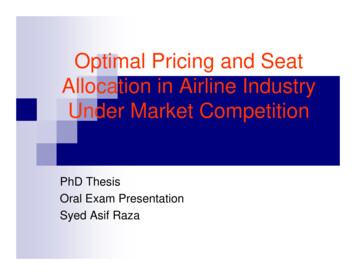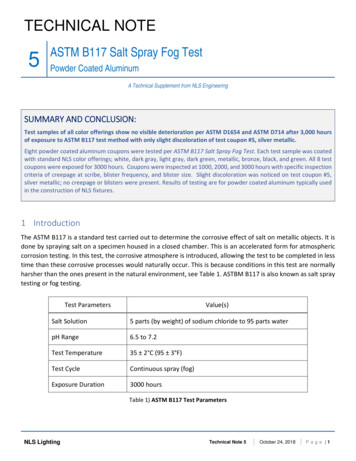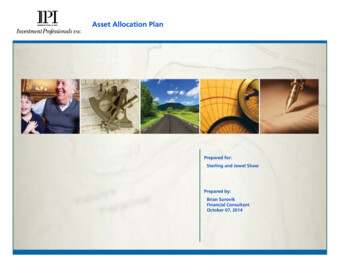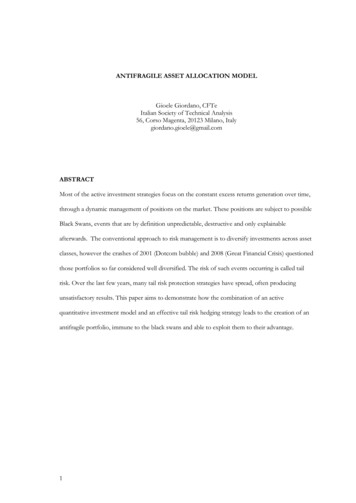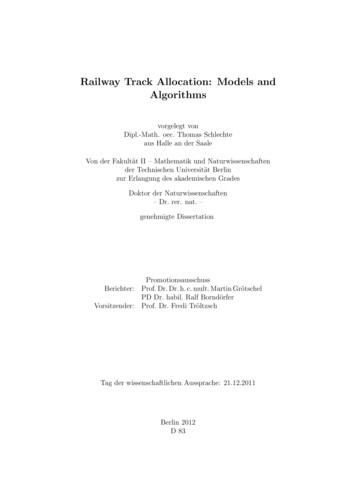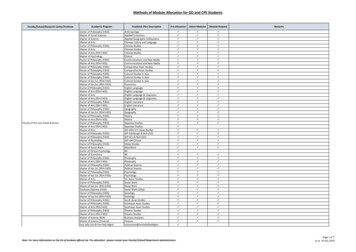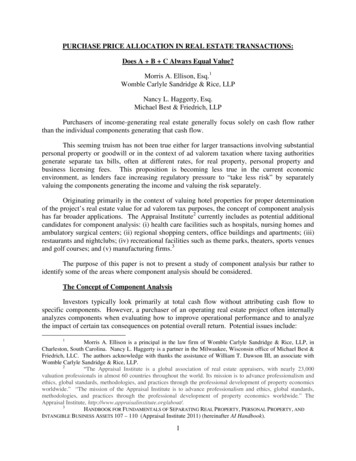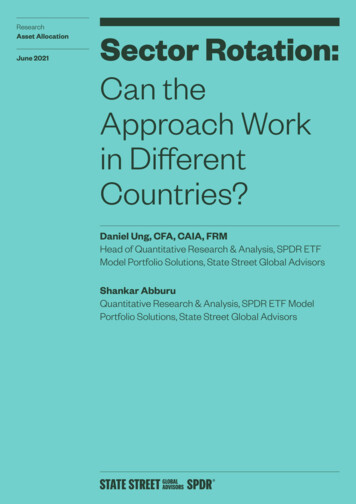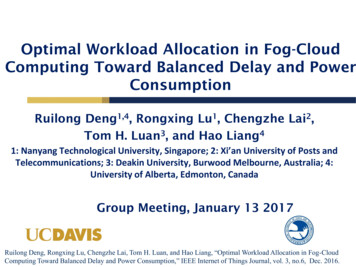
Transcription
Optimal Workload Allocation in Fog-CloudComputing Toward Balanced Delay and PowerConsumptionRuilong Deng1,4, Rongxing Lu1, Chengzhe Lai2,Tom H. Luan3, and Hao Liang41: Nanyang Technological University, Singapore; 2: Xi’an University of Posts andTelecommunications; 3: Deakin University, Burwood Melbourne, Australia; 4:University of Alberta, Edmonton, CanadaGroup Meeting, January 13 2017Ruilong Deng, Rongxing Lu, Chengzhe Lai, Tom H. Luan, and Hao Liang, “Optimal Workload Allocation in Fog-CloudComputing Toward Balanced Delay and Power Consumption,” IEEE Internet of Things Journal, vol. 3, no.6, Dec. 2016.
Outline1. Fog computing2. Fog-cloud computing system3. System model and problem formulation4. Decomposition and solution5. Numerical results6. ConclusionsRuilong Deng, Rongxing Lu, Chengzhe Lai, Tom H. Luan, and Hao Liang, “Optimal Workload Allocation in Fog-CloudComputing Toward Balanced Delay and Power Consumption,” IEEE Internet of Things Journal, vol. 3, no.6, Dec. 2016.2
What is fog computing? Fog computing is considered as an extension of the cloud computingparadigm from the core of network to the edge of the network. It is a highlyvirtualized platform that provides computation, storage, and networkingservices between end devices and traditional cloud servers [1]. ——from ciscoview. Fog computing is a scenario where a huge number of heterogeneous (wirelessand sometimes autonomous) ubiquitous and de-centralized devicescommunicate and potentially cooperate among them and with the network toperform storage and processing tasks without the intervention of third parties.These tasks can be for supporting basic network functions or new services andapplications that run in a sandboxed environment. Users leasing part of theirdevices to host these services get incentives for doing so [2]. ——from HPLab’s view.[1] F. Bonomi, R. Milito, J. Zhu, and S. Addepalli, “Fog computing and its role in the internet of things,” in Proceedings of the FirstEdition of the MCC Workshop on Mobile Cloud Computing, ser. MCC’12. ACM, 2012, pp. 13–16.[2] L. M. Vaquero and L. Rodero-Merino, “Finding your way in the fog: Towards a comprehensive definition of fog computing,” ACMSIGCOMM Computer Communication Review, 2014.3
What is fog computing? The fog extends the cloud to be closer to the things that produce and act on IoTdata. These devices, called fog nodes, can be deployed anywhere with anetwork connection: on a factory floor, on top of a power pole, alongside arailway track, in a vehicle, or on an oil rig. Any device with computing,storage, and network connectivity can be a fog node. Examples includeindustrial controllers, switches, routers, embedded servers, and videosurveillance cameras.[3] “Fog Computing and the Internet of Things: Extend the Cloud to Where the Things Are,” white paper, Cisco, 2015.4
What is fog computing? The OpenFog Consortium is defining a new architecture that can addressinfrastructure and connectivity challenges by emphasizing informationprocessing closer to where the data is being produced or used. OpenFogarchitecture intends to define the required infrastructure to enable building Fogas a Service (FaaS) to address certain classes of business challenges.[4] “OpenFog Architecture Overview,” white paper, OpenFog Consortium Architecture Working Group, Feb.2016.5
Examples of fog applications Fog applications are as diverse as the Internet of Things itself. What they havein common is monitoring or analyzing real-time data from network-connectedthings and then initiating an action. The action can involve machine-tomachine (M2M) communications or human-machine interaction (HMI). Examples include locking a door, changing equipment settings, applying thebrakes on a train, zooming a video camera, opening a valve in response to apressure reading, creating a bar chart, or sending an alert to a technician tomake a preventive repair. The possibilities are unlimited.[3] “Fog Computing and the Internet of Things: Extend the Cloud to Where the Things Are,” white paper, Cisco, 2015.6
When to consider fog computing? Data is collected at the extreme edge: vehicles, ships, factory floors,roadways, railways, etc. Thousands or millions of things across a large geographic area aregenerating data. It is necessary to analyze and act on the data in less than one second.Fog Nodes Extend the Cloud to the Network Edge[3] “Fog Computing and the Internet of Things: Extend the Cloud to Where the Things Are,” white paper, Cisco, 2015.7
What happens in the fog and the cloud?How to achieve the optimal workload allocation in fog-cloudcomputing is very important![3] “Fog Computing and the Internet of Things: Extend the Cloud to Where the Things Are,” white paper, Cisco, 2015.8
Main Contribution of This PaperIn this work, the tradeoff between power consumption and transmissiondelay in the fog-cloud computing system is investigated.They formulate a workload allocation problem which suggests the optimalworkload allocations between fog and cloud toward the minimal powerconsumption with the constrained service delay.The problem is then tackled using an approximate approach bydecomposing the primal problem into three sub-problems of correspondingsubsystems.They conduct extensive simulations to demonstrate that the fog cancomplement the cloud with much reduced communication latency.9
Fog-cloud computing systemOverall architecture of a fog-cloud computing system with four subsystems andtheir interconnections/interactions.10
System model11
System modelPower consumption of fog deviceFor the fog device i, the computation power consumption Pifog can bemodeled by a function of the computation amount xi, which is amonotonic increasing and strictly convex function.where ai 0 and bi, ci 0 are predetermined parametersComputing delay of fog deviceAssuming a queueing system, for the fog device i with the traffic arrivalrate xi and service rate vi, the computation delay (waiting time plusservice time) Dfogi is12
System modelPower Consumption of Cloud ServerEach cloud server hosts a number of similar computing machines. Theconfigurations (e.g., CPU frequency) are assumed to be equal for allmachines at the same server. Thus, each machine at the same server hasthe same power consumption. We approximate the power consumptionvalue of each machine at the cloud server j by a function of the machineCPU frequency fj :where Aj and Bj are positive constants, and p varies from 2.5 to 3 [5].Thus, the power consumption Pcloudj of the cloud server j can beobtained by multiplying the on/off state σj, the on-state machine numbernj, and each machine power consumption value.[5] L. Rao, X. Liu, M. D. Ilic, and J. Liu, “Distributed coordination of Internet data centers under multiregional electricity markets,” Proc.IEEE, vol. 100, no. 1, pp. 269–282, Jan. 2012.13
System modelComputation Delay of Cloud ServerThe M/M/n queueing model is employed to characterizeeach cloud server. For the cloud server j with the on/off state σj and njturned-on machines, when each machine has the traffic arrival rate yjand service rate fj/K, respectively, the computation delay Dcloudj is givenbyCommunication Delay for DispatchLet dij denote the delay of the WAN transmission path from the fogdevice i to the cloud server j. Thus, when the traffic rate dispatchedfrom the fog device i to the cloud server j is λij, the correspondingcommunication delay Dcommij is14
ConstraintsWorkload Balance ConstraintLet L denote the total request input from all front-end portals. Thetraffic arrival rate from all front-end portals to the fog device i isdenoted by li. Thus,Besides, let X and Y denote the workload allocated for fog computingand cloud computing, respectively. Then workload balance constraints:(1) for each fog device(2) for each cloud serverfor fog-cloud computing system15
ConstraintsFog Device ConstraintFor the fog device i, there is a limit on the processing ability due tophysical constraints. Let xmaxi denote the computation capacity of thefog device i. In addition, the workload xi assigned to the fog device ishould be no more than the traffic arrival rate li to that device. Fromthe above, we have(3)16
ConstraintsCloud Server Constraint(4)For the cloud server j,Besides, there is a limit on the computation rate of each machine dueto physical constraints. Let fminj and fmaxj denote the lower and upperbound on the machine CPU frequency, respectively(5)In addition, for the cloud server j, the number of machines nj has anupper bound nmaxj . Thus, for the integer variable nj,(6)Finally, the binary variable σj denote the on/off state of the cloud serverj.(7)17
ConstraintsWAN Communication Bandwidth ConstraintFor simplicity, the traffic rate λij is assumed to be dispatched from thefog device i to the cloud server j through one transmission path.Furthermore, these transmission paths do not overlap with each other.There is a limitation λmaxij on the bandwidth capacity of each path.Thus, the bandwidth constraint of the WAN communication is(8)18
Problem FormulationTowards the power consumption-delay tradeoff in fog-cloudcomputing, on one hand, it is important and desirable to minimizethe aggregated power consumption of all fog devices and cloud servers.The power consumption function of the fog-cloud computing system isdefined asOn the other hand, it is equally important to guarantee the quality ofservice (e.g., latency requirements) of end users. The end-user delayconsists of the computation (including queueing) delay andcommunication delay. Therefore, the delay function of the fog-cloudcomputing system is defined as19
Problem FormulationThe problem of minimizing the power consumption of the fog-cloudcomputing system while guaranteeing the required delay constraint Dfor end users.The decision variables are the workload xi assigned to the fog device i,the workload yj assigned to the cloud server j, the traffic rate λijdispatched from the fog device i to the cloud server j, as well as themachine CPU frequency fj, the machine number nj, and the on/offstate σj at the cloud server j. The objective of workload allocation inthe fog-cloud computing system is to tradeoff between: 1) the systempower consumption and 2) the end-user delay.20
Decomposition and solutionframework of power consumption-delay tradeoff by workload allocation in a fog-cloud computing systemNote that in primal problem (PP), the decision variables come from different subsystemsand are tightly coupled with each other, which makes the relationship between theworkload allocation and the power consumption-delay tradeoff not clear. To address thisissue, we develop an approximate approach to decompose PP into three SPs ofcorresponding subsystems.21
A. Power Consumption-Delay Tradeoff for Fog ComputingWe consider to tradeoff between the power consumption andcomputation delay in the fog computing subsystem. That is, we havethe SP1where the adjustable parameter ηi is a weighting factor to tradeoffbetween the power consumption and computation delay at the fogdevice i. After we obtain the optimal workload x i assigned to thefog device i, we can calculate the power consumption andcomputation delay in the fog computing subsystem, respectively.22
B. Power Consumption-Delay Tradeoff for Cloud ComputingAt the cloud server j, for the delay-sensitive requests, their responsedelay should be bounded by a certain threshold that is specified asthe service level agreement, since the agreement violation wouldresult in loss of business revenue. We assume that the responsedelay should be smaller than an adjustable parameter Dj, which canbe regarded as the delay threshold that identifies the revenue/penaltyregion at the cloud server j.We consider to tradeoff between the power consumption andcomputation delay in the cloud computing subsystem. That is,we have the SP223
B. Power Consumption-Delay Tradeoff for Cloud ComputingAfter we obtain the optimal workload y j assigned to the cloudserver j and the optimal solution f j , n j , and σ j , we can calculatethe power consumption and computation delay in the cloudcomputing subsystem, respectively, as24
C. Communication Delay Minimization for DispatchWe consider the traffic dispatch rate λij to minimize the communicationdelay in the WAN subsystem. That is, we have the SP3After we obtain the optimal traffic rate λ ij dispatched from the fogdevice i to the cloud server j, we can calculate the communicationdelay in the WAN subsystem as25
D. Putting it All TogetherBased on the above decomposition and the solution to three SPs, onone hand, the power consumption of the fog-cloud computingsystem is rewritten aswhich means that the system power consumption comes fromthe fog devices and cloud servers. On the other hand, the delayof the fog-cloud computing system is rewritten aswhich means that the system delay comes from the computationdelay of the fog devices and cloud servers, as well as thecommunication delay of the WAN. After solving the above threeSPs, we can approximately solve PP by considering the followingapproximate problem26
Numerical results (five fog devices and three cloud servers)Fog computing subsystemThey vary the workload X allocated for fog computing from 0 to 104, to evaluatehow they affect the power consumption Pfog(X) and computation delay Dfog(X) inthe subsystem. It is seen that both power consumption and computation delayincrease with the workload allocated for fog computing.27
Numerical results (five fog devices and three cloud servers)Cloud computing subsystemThen, they vary the workload Y allocated for cloud computing from 104 to 105, toevaluate how they affect the power consumption Pcloud(Y) and computation delayDcloud(Y) in the subsystem. The result shows that the computation delay stays steadywhile the power consumption increases with the workload allocated for cloudcomputing.28
Numerical results (five fog devices and three cloud servers)Fog-cloud computing system.Finally, based on the above x i and y j , we further solve SP3 and obtain thecommunication delay Dcomm(X, Y) in the WAN subsystem. Based on these wecalculate the system power consumption Psys(X, Y) and delay Dsys(X, Y). we notethat the power consumption of fog devices dominates the system powerconsumption, while the communication delay of WAN dominates the system delay.29
ConclusionsA systematic framework to investigate the power consumption-delaytradeoff issue in the fog-cloud computing system.The workload allocation problem is formulated and approximatelydecomposed into three SPs, which can be, solved within correspondingsubsystems.Simulation and numerical results are presented to show the fog’scomplement to the cloud.For the future work, a unified cost model may be built to achieve theoptimal workload allocation between fog and cloud.30
Thank you for your attention!Yongli ZhaoState Key Laboratory of Information Photonics and Optical Communications (IPOC),Beijing University of Posts and Telecommunications (BUPT), Beijing 100876, ChinaTel : 86-10-61198108; Email: yonglizhao@bupt.edu.cn; Web: ipoc.bupt.edu.cn31
Jan 13, 2017 · Towards the power consumption-delay tradeoff in fog-cloud computing, on one hand, it is important and desirable to minimize the aggregated power consumption of all fog devices and cloud servers. The power consumption functio
